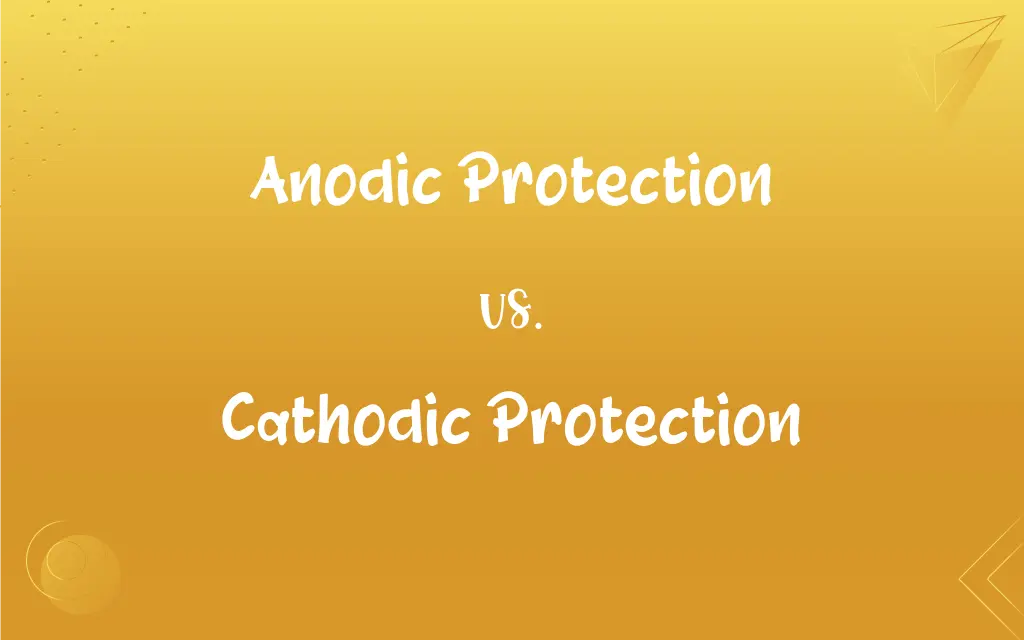Anodic Protection vs. Cathodic Protection: What's the Difference?
Edited by Aimie Carlson || By Janet White || Published on October 4, 2024
Anodic protection controls the corrosion of a metal surface by making it the anode of an electrochemical cell, while cathodic protection makes the metal a cathode, preventing corrosion.

Key Differences
Anodic protection involves applying a protective oxide layer to a metal to prevent corrosion, often used in aggressive environments. In contrast, cathodic protection involves redirecting the corrosive effects to a more easily corroded 'sacrificial metal'.
Anodic protection requires constant monitoring and control systems to maintain the correct potential, making it complex but effective for specific metals like stainless steel. Meanwhile, cathodic protection is simpler, commonly used for steel structures like pipelines and ships.
The application of anodic protection is limited to metals that passivate, such as stainless steel, whereas cathodic protection is versatile, applicable to a wide range of metals.
Anodic protection is often costlier due to its complexity and the need for continuous monitoring, whereas cathodic protection, once installed, requires minimal maintenance, making it more cost-effective.
In anodic protection, the potential of the metal surface is made more positive, whereas, in cathodic protection, the metal surface is made more negative relative to the corrosive environment.
ADVERTISEMENT
Comparison Chart
Principle of Operation
Makes metal surface an anode
Makes metal surface a cathode
Complexity and Monitoring
Complex with continuous monitoring needed
Simpler, minimal monitoring
Cost
Generally higher due to complexity
More cost-effective
Applicability to Metals
Limited to passivating metals
Applicable to a wide range of metals
Protective Mechanism
Protective oxide layer formation
Redirects corrosion to sacrificial metal
ADVERTISEMENT
Anodic Protection and Cathodic Protection Definitions
Anodic Protection
Method used for metals that passivate.
Anodic protection is ideal for certain types of steel.
Cathodic Protection
Passive protection system.
The bridge's cathodic protection system requires little maintenance.
Anodic Protection
Requires active control systems.
The plant installed anodic protection with monitoring systems.
Cathodic Protection
Suitable for various metal types.
Cathodic protection is versatile for different metallic structures.
Anodic Protection
Used in aggressive corrosive environments.
Anodic protection safeguards equipment in chemical plants.
Cathodic Protection
Often used for large structures.
Cathodic protection is essential for ship hulls.
Anodic Protection
Electrochemical protection by anodization.
Anodic protection was used for the stainless steel tank.
Cathodic Protection
Utilizes sacrificial anodes.
Cathodic protection was applied using zinc anodes.
Anodic Protection
Prevention of corrosion via positive potential.
Anodic protection requires precise potential control.
Cathodic Protection
Corrosion protection by making metal a cathode.
Cathodic protection is common for underground pipelines.
FAQs
Is anodic protection suitable for all environments?
Anodic protection is best in aggressive corrosive environments but is not universal for all conditions.
What types of metals are suitable for anodic protection?
Anodic protection is typically used for metals that can form a passive oxide layer, like stainless steel.
Is cathodic protection suitable for pipelines?
Yes, cathodic protection is commonly used for steel pipelines and underground structures.
Does cathodic protection require a lot of maintenance?
Cathodic protection is relatively low-maintenance once installed.
What is cathodic protection?
Cathodic protection is a method to control corrosion by making a metal surface a cathode, using sacrificial anodes.
Does anodic protection require constant monitoring?
Yes, anodic protection systems require continuous monitoring and control to maintain effectiveness.
Can anodic protection be used in the food industry?
Yes, especially for stainless steel containers and equipment in corrosive environments.
What is anodic protection?
Anodic protection is a technique to prevent corrosion by making a metal surface the anode in an electrochemical cell.
Is anodic protection cost-effective?
It can be costly due to its complexity and the need for continuous monitoring.
Is cathodic protection energy-intensive?
Cathodic protection can be energy-efficient, especially in systems using sacrificial anodes.
Can both anodic and cathodic protection be used simultaneously?
In rare cases, both methods can be combined, but it's complex and not common.
What factors influence the effectiveness of anodic protection?
Factors include the type of metal, the protective oxide layer's stability, and the environmental conditions.
Are there limitations to using anodic protection?
Anodic protection is limited to certain metals and requires specific environmental conditions to be effective.
Can cathodic protection be used on concrete structures?
Yes, it's used to protect reinforcing steel in concrete from corrosion.
What is a sacrificial anode in cathodic protection?
A sacrificial anode is a metal piece that corrodes instead of the protected metal in cathodic protection systems.
Can cathodic protection prevent all types of corrosion?
It's highly effective but may not prevent all forms, especially if improperly installed or maintained.
How does cathodic protection work?
Cathodic protection redirects corrosion to a more easily corroded 'sacrificial anode' instead of the protected metal.
How does the environment affect the choice between anodic and cathodic protection?
The choice depends on the corrosiveness of the environment and the type of metal being protected.
Can cathodic protection be used for ships?
Yes, it's often used to protect ship hulls and other large marine structures.
Are there environmental concerns with using anodic protection?
Environmental concerns are minimal, but the system must be properly designed and managed to avoid issues.
About Author
Written by
Janet WhiteJanet White has been an esteemed writer and blogger for Difference Wiki. Holding a Master's degree in Science and Medical Journalism from the prestigious Boston University, she has consistently demonstrated her expertise and passion for her field. When she's not immersed in her work, Janet relishes her time exercising, delving into a good book, and cherishing moments with friends and family.
Edited by
Aimie CarlsonAimie Carlson, holding a master's degree in English literature, is a fervent English language enthusiast. She lends her writing talents to Difference Wiki, a prominent website that specializes in comparisons, offering readers insightful analyses that both captivate and inform.






































































